From HOH to HUH: Physically Supporting AAC Learners
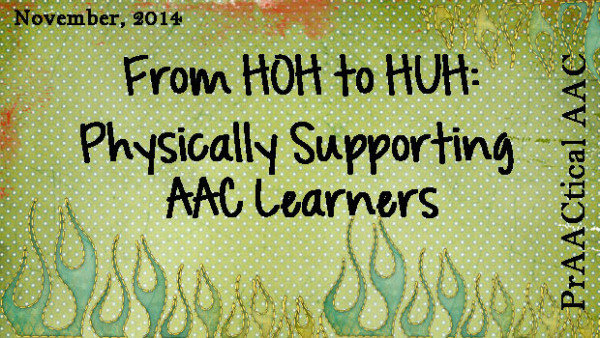
We’ve talked a lot about prompting strategies in previous posts, but today we look at one specific type: Physical assistance. Whether it is pointing to a symbol, activating the message window, turning pages in a communication book, or other early skills, beginning users of AAC often need a good deal of physical support to exhibit the desired behavior. Our first inclination may be to help the learner by using hand-over-hand (HOH) prompting, which is certainly effective in guiding them through the behavior. An even better way to support them, though, is hand-under-hand (HUH) prompting. With HUH, we guide learners by placing our hands under their hand (or just next to their hand) as we complete the desired behavior. HUH is frequently used with learners who have vision impairments and those who are deafblind. We find that it has much broader utility and can be a superior way of supporting some students with AAC needs.
Both types of support are effective in helping the learner to complete the desired behavior. We prefer hand-UNDER-hand in most instances, though. Here are some of our prAACtical thoughts.
- It feels more respectful. No one likes to be forced to do anything. With HUH, we’re doing it with them, not to them. That builds trust, the basis for all good intervention.
- It isn’t so pushy. It may feel quite intrusive to the learner to be physically made to do something. For some, that may lead to a bit of a power struggle with them focused more on the fact that they are being ‘made’ to do something, and less on the actual behavior we are trying to teach.
- It gives control to the learner. Usually when we use this, we are inviting them to participate. Most of us prefer that kind of autonomy.
- It encourages active participation. Both techniques are successful in getting the learner to complete a desired behavior. But HUH encourages their active participation (great for motor learning!) and reduces any tendency for passivity.
- It can be reassuring for learners. Some of our learners are reluctant to touch certain things, particularly if it is a new experience. With HUH, they are touching us, and we are manipulating the materials. That can help them get experience with the motor pathway without having to physically interact with the materials. Sometimes, this makes our learners more willing to participate.
In the video below, we see a young man with multiple disabilities being supported in this way. 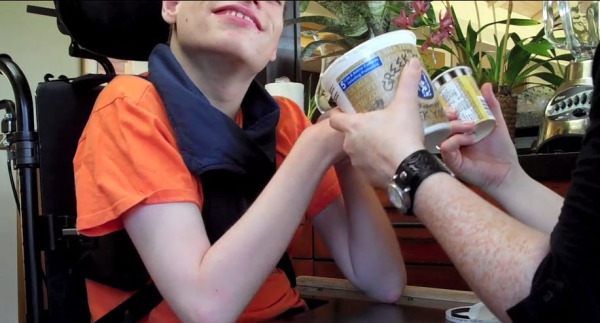
You can learn more about using the strategy here.
Do you use HOH or HUH? We’d love to hear about your experiences.
Filed under: PrAACtical Thinking
Tagged With: beginning communiator, deafblind, dual sensory impaired, hand under hand, physical guidance, prompting
This post was written by Carole Zangari

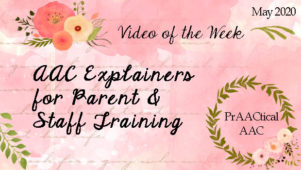

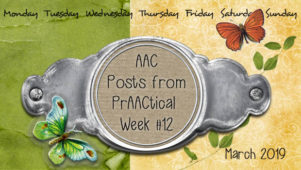
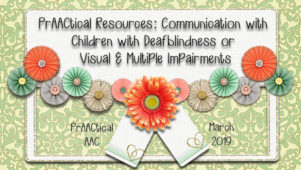
7 Comments
I was hoping this would be about the physical support young (small) AAC users need to have ready access to their device when they are not at a desk. What if you are not in a wheelchair but are not big or strong enough to carry your device?
what if you use crutches, or a white cane? No one expects the deaf to carry their sign interpreter. But device users are expected to carry their portable devices and also have the agility to flip them if they need/want to talk.
Whose job is it to carry the talker to the cafeteria if a child cannot?
Mary Ellen, in my experience, that is decided on a case-by-case basis as the needs of these students are all so different. I’ve seen a number of solutions to this (e.g., dsignating a staff member to do this, PT goals to help the student develop the skills to carry/manipulate the device, etc.). Clearly, if an ambulatory student is unable to carry or operate their device, there needs to be some provision for assistance. It seems to work best when the team looks at the situation and brainstorms to see what is best for that particular student.
I firmly believe that we should NOT use either HOH or HUH unless there is absolutely no other way. And I mean ABSOLUTELY as a LAST resort. If the child reaches and takes your hand of their own volition that is different. And even that should be faded quickly. But placing your hands under a child’s hand is really only the teeniest bit better than HOH. Touching a child – who invariably has not given consent – be it with HOH or HUH – teaches the child that it is OK for someone to touch and manipulate their body and in essence make them do something. Children with developmental disabilities have a 90% or better chance of physical or sexual assault over their lifetimes (citation below). We, as their educators and therapists and caregivers, should be putting abuse prevention at the highest of our priorities. Teaching children to communicate is paramount in that goal but if in the effort to teach communication we also teach that it is acceptable for another person to take your hands and move them – whether that is done by gently but forcefully picking up the hands and moving them or if it is done by placing your hands under the child’s hands and “guiding” is irrelevant. We must teach children that it is never, ever ok for someone to move or manipulate any part of their bodies without their consent. To those who invariably tell me that there is no other way I offer the following: reconsider why it is so important the child do the activity or engage with the materials in the way you think is “right”, what would happen if you let them explore without HOH or HUH?, have you tried other means of teaching such as modeling and using he child’s preferred learning modality to aid in them doing whatever it is you were going to do with HOH or HUH? Have you tried it for a long enough time? What about manipulating the materials instead of the child? Can you use positioning of the materials, lighting of the materials, coloring of the materials, adding or removing sensory features from the materials to entice the kind of interaction you wish the child to engage in? Have you charted out all the possible options of cueing and prompting and teaching before you when to HOH or HUH or any kind of physical cueing? Finally consider – if in five or ten or fifty years you hear this child was abused by someone moving/ manipulating/touching their hands or their bodies will you feel complicit in teaching the child, however accidently, that this was acceptable and that the child had to allow/comply/cooperate/accept this? If the answer is yes and you know the statistics about sexual assault and individuals with developmental and communication disabilities then stop. Stop and be creative, be a TEACHer, find a better way to get the job done.
(More than ninety percent (90%) of people (both male and female) with developmental disabilities will experience sexual abuse at some point in their lives. Forty-nine percent (49%) will experience ten or more abuse incidents. (Valenti-Hein, D. & Schwartz, L. (1995). The Sexual Abuse Interview for Those with Developmental Disabilities. James Stanfield Company. Santa Barbara: California)
Are there any papers written specifically about HOH?
Mattias, I’m sure there are others but this is the one that came to mind: http://journals.sagepub.com/doi/abs/10.1177/001440299806400406?journalCode=ecxc .
I agree that children being taught it is ok to be physically manipulated is wrong. However, my child is deaf/blind with multiple other severe disabilities. She will have nothing to do with Hoh or anyone “making” her do anything! But I have found Huh to be very beneficial to her. She controls where our hands go with limited help. I have tried numerous other approaches in the last nine years and still try new ones constantly, but to say that huh is not beneficial to her would be incorrect. I must say though, and I stress this; She doesn’t go anywhere alone, nor will she ever. She is always with either me( her mother) or her nurse of 7 yrs and she always will. Which is not to say something couldn’t happen to her, sexual assault or otherwise. I am just not sure asking a child that can’t see or hear to do much without some kind of physical interaction to be very effective. And without any kind of physical interaction for a deaf/blind child must be very lonely. Again, I am only commenting on what works for our specific situation and the reason she doesn’t go anywhere without one of us is because we do know the statistics. Everyone should do their due diligence before sending any child anywhere, but especially one that can’t tell you what is happening. btw, with huh, she has learned how to walk with a walker without support and “more”, “all done”, ” hi” and “bye” on her AAC device, as well as activate toys by first being shown by huh, we try to fade it out as quickly as possible and if she doesn’t want to nobody forces her. I believe if it was unwanted touch, she would pull away like she does if anyone tries hoh. Once again though, I must say these are just our specific circumstances and I am not saying it is right for anyone else. I am just stating what has worked for us.
Hi, this is super interesting! I’m just wondering how it is faded. With any prompting, it’s important to have a plan for how to fade the prompt and allow for independence. If the adult’s hands are under the learner’s hands, what would the next step be in the fading process? How is independence ultimately achieved? Thanks!